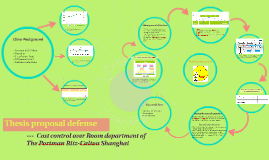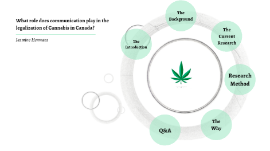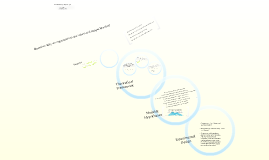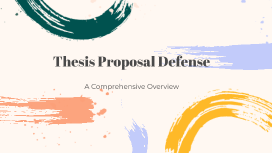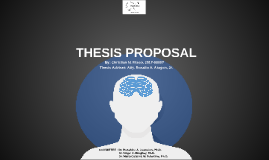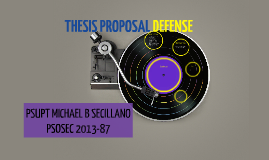Thesis Proposal Defense
Transcript: Potential Biases Research Findings Contribution to the Field Potential biases can stem from sampling, researcher perspectives, or data collection methods. Addressing biases is critical to upholding the credibility and rigor of research outcomes. Recognizing and mitigating biases enhances the study's validity and trustworthiness. Numerous significant insights were uncovered during the study, leading to intriguing findings that reshape current perceptions of the topic. Impact of Research This section highlights the significant impact of the research and the novelty of the findings. Limitations Overview The research presented in this thesis proposal defense seeks to make a meaningful contribution to the field by addressing gaps in existing knowledge and providing valuable insights that can potentially shape future scholarship. Results Overview Data Interpretation (Continued) The research findings revealed a correlation between X and Y, highlighting the impact of Z on the study's outcomes. This overview sets the stage for a detailed analysis of the data interpretation. Further examination of the data revealed nuances that offer profound implications for future research directions and potential applications in the field. The depth of analysis unraveled complexities within the findings, enhancing the overall understanding of the study. Study Constraints Novelty of Findings Study Constraints and Potential Biases are crucial aspects of any research study, impacting the reliability and validity of findings. Understanding and addressing these limitations is essential for a comprehensive evaluation of research outcomes. Data Interpretation Study constraints encompass limitations faced during the research process, such as time, budget, or resource constraints. Identifying and acknowledging these constraints is vital for transparency and methodological clarity. The findings of this study offer a fresh perspective on the subject matter, introducing new ideas and approaches that have the potential to influence and advance the field in a unique and innovative way. Through meticulous analysis, the data interpretation showcased a noteworthy trend in the relationship between variables A and B. These insights shed light on the underlying mechanisms influencing the research outcomes. Methodology Overview Exploring Future Directions Research Design Research methodology is fundamental for designing, collecting, and analyzing data in a systematic manner to answer research questions effectively. Thesis Proposal Defense The research design outlines the structure and strategy for data collection and analysis, ensuring a systematic approach to address research questions. Actionable Recommendations In the realm of future directions, it is imperative to explore promising research opportunities that can expand the current thesis findings. Recommendations derived from the thesis findings provide actionable insights for future research endeavors, guiding the trajectory of the academic discourse significantly. Example: Survey Research Design Data Collection Methods In a survey research design, data is gathered from a sample population through structured questionnaires to gather opinions, attitudes, and preferences on specific topics. Choosing appropriate data collection methods, such as surveys, interviews, or observations, is critical for obtaining reliable and relevant data aligned with research objectives. A Comprehensive Overview Promising Research Opportunities Research opportunities offer avenues for extending the scope of the study, potentially leading to innovative breakthroughs and advancements. Data Analysis Techniques Effective data analysis techniques, including statistical analysis and thematic coding, are essential for deriving meaningful insights and patterns from collected data. Significance of Findings Introduction Highlighting the importance and impact of the research outcomes in the academic and practical context. Theoretical Framework Implications for Future Research The Theoretical Framework provides the conceptual backbone for the study, guiding the research design and analysis. By drawing upon established theories and models, this section establishes a solid foundation to interpret data and draw meaningful conclusions. Summary Discussing the potential implications of the study for future research directions and areas of exploration. Objectives Summarizing the key research findings and their significance in addressing the research objectives. Research background sets the stage for the study's significance. Understanding it is crucial for the thesis proposal defense. Previous Studies Key Concepts Literature Review Building upon the works of notable researchers, this section synthesizes the findings, methodologies, and gaps identified in Previous Studies. Valuable insights are gained to inform the current research direction effectively. Key Concepts are fundamental elements that shape the discourse within the research






